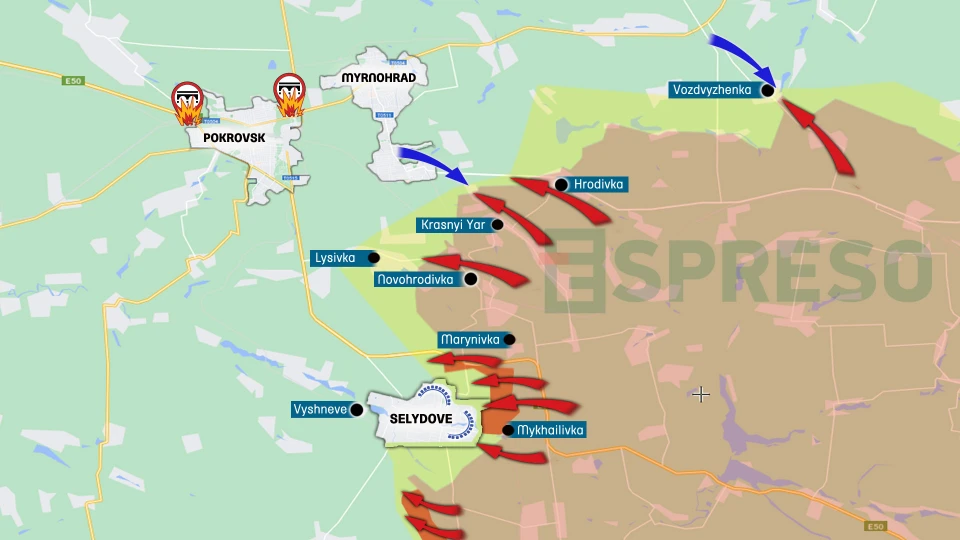
40% of Selydove under Russian control amid 70,000 troops operating in Pokrovsk direction. Serhiy Zgurets' column
The distance between Selydove and Pokrovsk is about 18 kilometers. This area is extremely complex, and most combat clashes are taking place here today
Russian troops' offensive on Selydove
The 15th Brigade of the National Guard Kara-Dag, which was redeployed there in August when the Russians intensified their actions in the Pokrovsk direction, is holding the defense in Selydove. Since Monday, the situation has become critically complicated. The Russian forces began artillery training, which lasted about 20 hours, shelling Ukrainian positions. After that, the attack began from three directions: north, south and east. Selydove is vulnerable because of two roads that ensure the functioning of the town. One of them leads to Vyshneve, and the advance to this settlement by rail became possible after the Russians captured Tsukuryne and Ukrainsk.

After the capture of Novohrodivka, the situation in the north has become more complex due to disruptions to the logistical routes supplying Selydove. Attacks from the east are ongoing, with Russian troops attempting to penetrate the suburban areas. Reports suggest that assaults are occurring almost every 20 minutes by small groups of Russian forces. They have partially entered the suburbs, and Russian flags have appeared on some buildings. Nevertheless, the Kara-Dag brigade continues to hold the line, although approximately 40% of the city is under Russian control. The Solona River divides the city into two parts, with the northern and northwestern areas remaining under Ukrainian control.
Following artillery bombardments, the Russian forces have significantly increased the deployment of electronic warfare systems that hinder the Ukrainian Armed Forces’ FPV drone operations. Daily, 10-12 Orlan and Zala reconnaissance drones fly over Selydove, aiding Russian forces in adjusting artillery fire, which further complicates the Ukrainian forces' efforts. A spokesperson for the Kara-Dag brigade stated that the units continue to hold back Russian advances, although the situation remains extremely challenging due to fighting on three fronts. Additionally, Russian units have a notable advantage in both manpower and equipment.
According to the Information Resistance group, around 70,000 Russian troops are operating in the Pokrovsk direction, with 15,000 of these held in reserve. Russian forces have amassed approximately 1,000 artillery systems in the area, the highest concentration across all fronts. This combination of artillery, manpower, and electronic warfare significantly impacts the Ukrainian Armed Forces' defenses. However, if the Kara-Dag brigade and other units withdraw from Selydove, it would not be a critical loss. Finding a balance between holding the city and repositioning to avoid excessive casualties, as in the case of Vuhledar, remains crucial.
Deputy Defense Minister Ivan Havryliuk stated that the ammunition supply for the Ukrainian armed forces has improved. The artillery fire ratio between Ukrainian and Russian forces is now about one to two, a significant improvement from earlier in the year when the ratio was 1:7 or worse. This change suggests either an improvement in ammunition supplies for the Ukrainian Armed Forces or a decline in Russian supplies due to the destruction of key artillery depots. It is known that at least three major arsenals of the Russian GRAU were destroyed, likely impacting ammunition supplies across various frontlines. Although Havryliuk noted that Russian forces still face no restrictions on artillery shell usage, the improved fire ratio is an encouraging sign. This trend is critical to consider, especially as future ammunition supplies from international partners are expected to increase.
Modern technological models for Ukraine's Armed Forces
Ukrainian startup Buntar Aerospace is developing an unmanned long-range reconnaissance aircraft system called the Buntar-1. Bohdan Sas, co-founder and Chief Product Officer (CPO) of Buntar Aerospace, explained the unique features of the unmanned reconnaissance system.
“At the front, it is essential to destroy the enemy using both guided and unguided munitions. For this, we need to identify targets from the air, which remains the most effective detection method. We have in-depth expertise in aerial combat and reconnaissance, and we’re digitizing this experience, gained from various military units, into products designed for reconnaissance and target destruction,” he said.
In working with the drone, the company identified two major challenges, Sas explained: “These are the limitations of drone hardware and control systems, as well as the training of personnel. Since the start of the full-scale invasion in 2022, the number of armed forces has grown significantly, and inexperienced crews are now operating the expensive systems already in service. This is where artificial intelligence becomes essential. The software assists operators in controlling drones more efficiently and safely, improving their ability to locate and reconnoiter targets, as well as maintain the aircraft. Economics plays a critical role in modern warfare. There have been cases where an expensive aircraft worth $100,000–$200,000 was lost on its second flight due to crew errors. By digitizing the expertise of the most experienced crews, we can enable other operators to use the aircraft more effectively and safely,” he explained.
Samples of the Buntar-1 system are currently in use on the battlefield.
“We’ve made significant progress on development over the past six months. The product has been finalized and is already deployed by the military in the combat zone. The feedback has been very positive. We are also a member of the Brave1 cluster, established by the Ministry of Digital Transformation, and are actively working toward obtaining government approvals. This would enable the product to be purchased not only through donations, grants, and sponsorships but also directly by military units in need,” said Sas.
The startup has raised nearly $1 million from private investors. The commitment of team members, co-founders, and investors plays a significant role in building the company, said Sas. According to him, there is a shared vision of creating a robust component of the Ukrainian defense industry to counter aggression. It is also a valuable opportunity to apply this experience to future conflicts or potentially prevent them.
“There is considerable interest from Western countries. We’ve attended conferences and held closed demonstrations for NATO armies, receiving positive feedback. Additionally, we’ve had the opportunity to train members of the Ukrainian Armed Forces in the tactics and methods we use. Ukraine has much to teach the West, and we are sharing this knowledge. Over 60 people are currently working on the project, focusing on several areas: software development, mission planning and execution systems, the modernization and improvement of Buntar-1, and other products. For instance, there is a high demand for the capability to destroy targets identified by the reconnaissance vehicle, and our team is actively addressing this. Mass production is underway, marking a significant expansion of capabilities for the defense forces,” said Sas.
- News













































